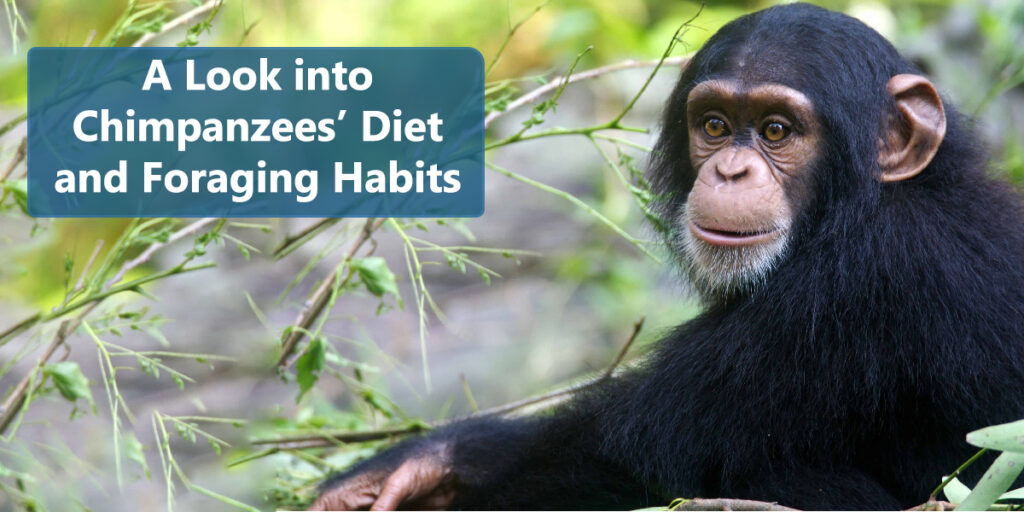Chimpanzees have diverse and fascinating diets, influenced by their surroundings, availability of food, and even cultural habits within groups. As our closest relatives in the animal kingdom, chimpanzees share around 98% of our DNA. Their eating habits, though simple at first glance, reveal remarkable complexity when examined closely. In this article, we’ll explore what chimpanzees eat, why they make specific dietary choices, and how these choices vary across groups and regions.

Overview of Chimpanzee Diet
Chimpanzees are omnivores, which means they eat both plant-based foods and animal matter. Their diet is diverse, consisting of fruits, leaves, seeds, insects, and occasionally meat. The variety in their diet is a survival strategy, allowing them to adapt to seasonal changes in food availability. However, the bulk of a chimpanzee’s diet is plant-based, with fruits being a top choice.
Fruits – A Favorite Food
Fruits make up a significant portion of a chimpanzee’s diet. Depending on the region and season, fruits can account for up to 50% of their daily food intake. Chimpanzees often travel long distances to find fruit trees and spend hours picking and eating the ripe fruit. They have a strong preference for high-calorie fruits, which provide the energy they need for daily activities. Some of their favorites include figs, bananas, and mangoes.
Chimpanzees rely on their excellent memory to remember the location of fruiting trees, returning to them year after year. Their high dependence on fruit makes them an essential part of their ecosystem, as they help disperse seeds through their droppings, aiding in forest regeneration.
Leaves and Plant Matter
When fruits are scarce, chimpanzees turn to leaves, stems, and bark for nutrition. While not as calorie-dense as fruit, leaves provide essential nutrients like fiber and protein. Some plant species also have medicinal properties, which chimpanzees seem to recognize. For example, they sometimes eat leaves that contain anti-parasitic compounds, helping them ward off intestinal parasites.
Leaves are more commonly eaten in the dry season when other food sources are limited. Chimpanzees often select young, tender leaves, which are easier to chew and digest than mature ones. They show remarkable knowledge of local plant varieties, selectively choosing leaves from specific plants based on their needs.
Seeds and Nuts
Chimpanzees also consume seeds and nuts, though these are less common in their diet. Seeds and nuts provide protein and healthy fats, which are important for energy. Some seeds require cracking, and chimpanzees use stones or branches as tools to access these foods.
Their use of tools shows their intelligence and adaptability. For example, chimpanzees in certain areas have been observed using rocks to crack open nuts—a skill passed down through generations and specific to certain chimpanzee populations. This behavior suggests that chimpanzees have cultural variations in diet, with some groups specializing in nuts more than others.
Insects – A Source of Protein
Chimpanzees are skilled insect hunters. Termites, ants, and bees are among the most common insects in their diet. Insects provide a good source of protein and fats, which are especially valuable during times when fruits are less abundant. Chimpanzees have been observed using sticks to “fish” for termites, a skill learned from watching other members of their group.
Termite fishing is a precise and delicate process. Chimpanzees insert a stick into a termite mound and wait patiently for termites to climb onto it before pulling the stick out and licking off the insects. This behavior highlights their problem-solving skills and dexterity. Some chimpanzees also eat ants and caterpillars, although termites remain the most commonly consumed insect.
Meat – An Occasional Treat
Chimpanzees do eat meat, but it makes up a small portion of their diet. Meat consumption varies by region, with some chimpanzee populations eating it more frequently than others. Their meat diet primarily includes small mammals like monkeys, birds, and occasionally, small antelopes. Hunting is usually a group activity, where chimpanzees cooperate to catch prey. They often display coordinated hunting techniques, with some chimps chasing the prey while others wait to ambush.
Chimpanzees’ taste for meat is believed to fulfill their need for protein and certain minerals. However, hunting is rare and typically occurs only when other food sources are low. Not all chimpanzee groups hunt, suggesting that hunting is both a cultural and learned behavior.
Honey – A Sweet Treat
Honey is a favorite treat for chimpanzees whenever they can find it. Chimpanzees will go to great lengths to access beehives, sometimes risking painful stings for the reward of honey. Honey provides a quick source of energy due to its high sugar content. To get to honey, chimpanzees use sticks or branches to break into the hive and scoop out the liquid. This is another example of tool use in chimpanzees, demonstrating their intelligence and determination.
Water and Hydration
Chimpanzees get a significant amount of water from the fruits and leaves they consume. However, they do drink directly from water sources as well. To drink, chimpanzees often dip leaves into water and suck the liquid from them. This behavior helps them avoid bending down into the water source, where they might be vulnerable to predators. Leaf-dipping is also another example of tool use in chimpanzees, highlighting their clever adaptations to their environment.
Regional and Cultural Differences in Diet
Chimpanzees’ diets vary based on location and the resources available in their habitat. For example, chimpanzees in western Africa consume more nuts than those in eastern Africa, where nuts are scarcer. Similarly, chimpanzees in some regions have developed unique ways of catching insects, while others rely more heavily on plant-based diets.
These regional differences in diet have led researchers to observe cultural practices in chimpanzees. Tool use, hunting methods, and even food preferences can differ among groups, passed down through generations. This variation showcases their adaptability and intelligence and hints at the social learning that plays a role in chimpanzee communities.
Seasonal Adaptations
Seasons affect food availability, and chimpanzees adapt their diet accordingly. In the rainy season, when fruits and insects are more abundant, chimpanzees eat more of these high-energy foods. During the dry season, when food is less plentiful, they rely more on leaves, stems, and seeds.
This seasonal shift allows them to maintain a balanced diet year-round. By diversifying their food sources and adjusting their eating habits with the seasons, chimpanzees demonstrate remarkable flexibility. This adaptability is key to their survival, as it allows them to thrive in diverse environments and climates.
Conclusion of What do chimpanzees eat
Chimpanzees have a varied diet that includes fruits, leaves, seeds, insects, and occasionally meat. Their dietary choices reflect not only the resources available to them but also their intelligence and social learning. From remembering fruit trees to using tools for hunting, chimpanzees show advanced problem-solving skills and adaptability. Their eating habits, though simple at first glance, reveal complex behaviors shaped by culture, environment, and season. By understanding what chimpanzees eat, we gain insight into their lives and the rich biodiversity of their habitats.










Септики под ключ: современные системы для частного дома
сколько стоит установить септик под ключ http://www.septic-pod-kluch-msk.ru/ .
Прыжки с парашютом в тандеме: эмоции, которые вы никогда не забудете
купить сертификат прыжок парашютом http://pryzhki-s-parashyutom-v-spb.ru/ .
Купить зимние шины с гарантией надежности и отличного сцепления
автошины купить в спб https://www.kupit-shiny-spb.ru .
Всё о лизинге грузового транспорта: минимальные риски и максимум выгоды
грузовая техника в лизинг грузовая техника в лизинг .
Современные деревянные дома под ключ: элегантный дизайн и долговечность
деревянные дома под ключ проекты и цены http://www.derevyannye-doma-pod-klyuch777.ru/ .
Строителство на сглобяеми къщи: практични и изгодни решения за всеки
сглобяеми къщи цени http://www.sglobyaemi-kushti.com .
Каркасные дома с коммуникациями: готовое жильё для заселения
каркасный дом санкт петербург https://karkasnye-doma-v-spb178.ru .
Казино Клубника: ежедневные акции и турниры для азартных игроков
клубника казино официальный сайт http://www.goo.su/rcfb .
Готовый каркасный дом под ключ: комфорт и стиль за короткие сроки
каркасные дома в спб https://karkasnye-doma-v-spb-pod-kluch1.ru/ .
Интернет-магазин шин: качественные шины, которые подойдут каждому авто
интернет магазин шин с доставкой интернет магазин шин с доставкой .
Наклейки со смолой: идеальное решение для брендов и промо-материалов
стикеры со смолой на заказ https://xn—–7kcbbyacb2akkclkqcl8a3dxf3b0a4b.xn--p1ai/ .
Надёжная спецтехника от ведущего производителя в отрасли
продажа грузовых автомобилей спецтехники http://www.proizvodstvo-spectekhniki.ru .
Экран для проектора: доступные цены на модели любого размера
проекционный экран цена https://proekcionnye-ehkrany.ru/ .
Подключение интернета для офисов: доступные тарифы и круглосуточная поддержка
подключение интернета для юридических лиц https://www.internet-v-ofis1.ru .
заказать москитную сетку
https://moskitka-proizvodstvo.ru/
Современная психиатрическая клиника в Санкт-Петербурге: все услуги в одном месте
частная психиатрическая клиника в спб http://www.psihiatricheskaya-klinika-spb-0.ru/ .
Контрактные моторы с минимальным пробегом и полным комплектом документов
двигатель контрактный https://www.kontraktnye-dvigateli-moskva-1.ru .
Продажа новых фронтальных погрузчиков по лучшим ценам
китайский погрузчик xn—-7sbkqfclcqchgmgkx0ae6eudta.xn--p1ai .
Бу автозапчасти для любых моделей авто: надежно, выгодно, удобно
бу запчасти для иномарок https://zapchasti-bu-moskva-1.ru/ .
Профессиональные сантехники: монтаж отопления, устранение протечек, замена оборудования
вызвать сантехника https://www.sanmontazh1.ru .
Ремонт протекающих соединений: услуги сантехника с заменой изношенных деталей
вызов сантехника спб https://www.24santehnick-1.ru/ .
Наркологическая клиника с уютными палатами и индивидуальным уходом
наркологический центр санкт петербург http://platnaya-narkologicheskaya-klinika.ru/ .
Лучшие игровые автоматы и слоты ждут вас на Mostbet
mostbet o\’ynash http://www.mostbet-uz-bet.top .
Круглосуточная доставка алкоголя на дом: широкий ассортимент для вашего отдыха
алкоголь на дом https://www.dostavka-alcogolya-nochyu-world.ru/ .
Онлайн-доставка алкоголя: широкий выбор и качественное обслуживание
доставка алкоголя 24 http://www.dostavka-alcogolya-nochyu-club.ru .
Как избавиться от засора? Услуги сантехника с современным оборудованием
сантехник спб срочно http://www.remontson1.ru .
Быстрая и надежная помощь сантехника для вашего дома или офиса
вызов сантехника на дом спб вызов сантехника на дом спб .
Как суррогатной матери получить компенсацию: финансовые аспекты программ
ищу суррогатную мать http://mammalogy.su/ .
Почивка на Гран Канария: райски отдих, най-добрите места за почивка.
Гид за плажовете на Гран Канария: изберете идеалното място за слънчева баня.
Гран Канария за гурмани: опитайте най-добрите ястия на острова.
Екскурзии на Гран Канария: открийте историята на острова.
Спа хотели на Гран Канария: релаксирайте и се наслаждавайте на почивката.
Гран Канария: активна почивка за деца и възрастни.
Оферти за почивка в Гран Канария https://www.bohemia.bg .
Защита бизнеса от недобросовестной конкуренции: квалифицированный антимонопольный юрист
антимонопольные юристы https://www.antimonopolnii-yurist.ru .
Make stamps online with pre-designed templates – no experience required
make stamps online https://make-stamp-online0.com .
Снять квартиру на сутки в Гродно недорого: скрытые лайфхаки поиска
квартиры на сутки в Гродно без посредников квартиры на сутки в Гродно без посредников .
Наркологическая клиника с лицензией: безопасное лечение зависимостей в стационаре
частная наркологическая клиника http://www.platnaya-narkologicheskaya-klinika1.ru/ .
Продажа кабин для спецтехники с доставкой по России — гарантия качества
кабина спецтехника https://www.xn—–6kceqhatfamjizg3a7au2dr1h5d.xn--p1ai/ .
Create date stamps and approval seals – quick tools in stamp creator online
stamp creator online free http://www.make-stamp-online1.com/ .
Best stamp maker online for address, logo, and signature stamps
stamp maker https://www.make-stamp-online-1.com .
Create signature stamps for official documents – simple stamp creator online
stamp creator online http://www.make-stamp-online-0.com .
I’ve been waiting to feel your touch… ready? – https://rb.gy/es66fc?artire
Create a unique cover letter in 3 clicks – no registration needed
cover letter generators https://www.aicoverlettergenerator.pw/ .
AI cover letter generator: Beat competition with tailored content
coverletter generator https://www.createcoverletterfree.press/ .
How to turn affiliate programs into a lucrative income stream – Expert tips inside
affiliate programs http://www.affiliate-b1.com/ .
Датчик давления в шинах с гарантией качества: обеспечьте безопасность своего автомобиля.
датчики tmps https://www.datchik-davleniya-v-shinah.ru/ .
Каркасные дома с усиленным каркасом: устойчивость к ветру и снеговым нагрузкам
каркасные дома в спб http://karkasnye-doma-vspb178.ru/ .
Коммерческий автотранспорт в лизинг: защита от инфляции и рост вашей прибыли
лизинг оборудования для юридических лиц kommercheskiy-avtotransport-v-lizing.ru/oborudovanie .
Лизинг коммерческого транспорта с фиксированной ставкой: защита от колебаний курса валют
спецтехника лизинг спецтехника лизинг .
Быстровозводимые каркасные дома: решение для тех, кто не любит ждать
каркасный дом под ключ спб http://www.karkasnye-doma178.ru .
Строительство каркасных домов под ключ: выбирайте качество и доступность
каркасные дома под ключ в спб цены http://www.karkasnye-doma-pod-klyuch-v-spb178.ru/ .
Каркасный дом под ключ для комфортной жизни за городом
строительство каркасных домов под ключ http://www.karkasnye-doma-pod-kluch178.ru/ .
Оформление временной регистрации через компанию: Какие преимущества вы получите
временная регистрация в москве https://rega-msk99.ru .
Каркасный дом под ключ: строительство, которое идет в ногу с вашими желаниями
дома каркасные karkasnye-doma-spb178.ru .
Каркасный дом: узнайте секреты строительства от профессионалов, которые знают все о надежности и стиле
каркасные дома санкт петербург spb-karkasnye-doma178.ru .
Проблемы с водой в доме? Услуги сантехника от нашей компании вернут вам спокойствие
сантехник спб недорого https://vizov-santehnikavspb.ru .
Машинка на пульте радиоуправления: как подобрать модель по возрасту и интересам – полное руководство у нас
машина пульт https://www.wildberries.ru/catalog/281617142/detail.aspx/ .
Комплексные сантехнические услуги – работаем быстро и аккуратно
вызов сантехника http://www.uslugisantehnika-spb.ru/ .
Машинка на пульте: почему дети и взрослые обожают наши товары – убедитесь сами
купить радиоуправляемую машину wildberries.ru/catalog/281617142/detail.aspx .
Cover letter generator with LinkedIn profile integration
cover letter ai generator http://www.writingcoverletterai.com/ .
Услуги сантехника по замене труб, кранов и смесителей без переплат
сантехник срочно http://www.santehniknadom-spb.ru .
Craft cover letters that highlight your skills and achievements
cover leter generator http://www.createcoverletterfree.com .
Преимущества займов онлайн – удобство, скорость и доступность
займ vsezajmyonline.kz .
Тренажеры Матрикс – инновационные технологии для максимальной эффективности занятий
тренажеры матрикс https://matriks-trenajeri.ru/ .
Unlock Bitcoin Cash. $8252 Ready Now – https://t.me/+HkY2o13tXmtjY2My?wevy66cew
Займы онлайн без лишних документов, скрытых комиссий и бумажной волокиты
займы https://www.vsemiikrozajmy.kz .
Нужны деньги? Микрокредиты с мгновенным решением
микрокредиты http://allmikrokredits.kz/ .
Элегантность и стиль в каждой детали.
Мебель премиум-класса https://www.byfurniture.by/ .
Микрокредит без залога и справок – деньги за 5 минут
микрокредиты в Казахстане https://www.mikrokredityvsem.kz .
Круглосуточные займы онлайн с удобным оформлением и гибкими условиями
онлайн займ http://news365.kz/ .
Клининг с гарантией 48 часов: Если что-то не понравится — приедем повторно
клининг в москве цена клининг в москве цена .
Клининг Москва: Уборка без стресса — оставьте заявку, а мы сделаем всё идеально
лучшая клининговая компания https://kliningovye-kompanii-1.ru .
Ihfuwhdjiwdjwijdiwfhewguhejiw fwdiwjiwjfiwhf fjwsjfwefeigiefjie fwifjeifiegjiejijfehf https://uuueiweudwhfuejiiwhdgwuiwjwfjhewugfwyefhqwifgyewgfyuehgfuwfuhew.com
Help me get 1000 subscribers – https://t.me/+8YD4vOIJpnk4ZmVh
In my channel I share information about promotion, marketing, crypto and personal life.
Thank you, good person!
HeExpege
Секреты выбора дизайнерской мебели для вашего дома.
Мебель премиум byfurniture.by .
Cekpot vurmaq istəyirsiniz? Pinco Casino-da ən böyük mükafatlar sizi gözləyir
pinco casino az http://www.pincocasinogiris-az.com .
Авторазборка в наличии – тысячи запчастей с гарантией на работоспособность
авторазборка https://avtorzborka3-moskva.ru .
Si te gusta los casinos online en Espana, has llegado al portal correcto. Aqui encontraras informacion detallada sobre los plataformas mas seguras disponibles en Espana.
Beneficios de los casinos en Espana
Casinos regulados para jugar con proteccion completa.
Ofertas para nuevos jugadores que aumentan tus posibilidades de ganar.
Amplia variedad de juegos con premios atractivos.
Depositos y retiros sin problemas con multiples metodos de pago, incluyendo tarjetas, PayPal y criptomonedas.
Ranking de los mejores operadores en Espana
En nuestra guia hemos recopilado las opiniones de expertos sobre los casinos con mejor reputacion en Espana. Consulta la informacion aqui:
casinotorero.info
Abre tu cuenta en un casino confiable y aprovecha todas las ventajas.
Free rubber stamp design tool – create and print high-resolution digital stamps
stamp maker online free https://make1-stamp-online.com .
Free rubber stamp tool – perfect for branding, official use, and more
stamp making online stamps1-creator.com .
Светодиодные светильники от производителя для создания комфортного освещения в любом помещении
магазин светотехники https://proizvodstvo-svetodiodnih-svetilnikov.ru .
Подписка на Spotify премиум без рекламы и ограничений
подписка в спотифай подписка в спотифай .
Камера заднего вида с интеллектуальной системой распознавания препятствий
камера заднего вида купить в спб http://www.camera-zadnego-vida.ru .
Элегантность и стиль в каждой детали.
Мебель премиум-класса https://www.byfurniture.by/ .
Туры Fun Sun: отправляйтесь в Турцию с комфортом, забронируйте.
Туроператор Фан Сане туры в Турции из Москвы Туроператор Фан Сане туры в Турции из Москвы .
Лучшая сантехническая помощь в СПб – цены, акции и выгодные предложения
вызов сантехника на дом стоимость услуги https://remont-santehniki-price.ru/ .
Сантехник СПб – прайс и скидки на все виды работ
услуги сантехника стоимость santeh1-montazh-price.ru .
Надежная и прочная мебель для кафе – большой ассортимент на любой бюджет
банкетная мебель купить https://mebel-dlya-kafe.ru/ .
Комплексный подход к разработке технологической карты на погрузочно-разгрузочные работы
технологическая карта на погрузочно разгрузочные работы http://www.tekhnologicheskie-karty.ru/ .
Разработка ППРК с точным расчетом рисков и повышением производительности
ппр кранами http://pprk-msk.ru/ .
Клининг в Москве: рейтинг лучших исполнителей по соотношению цена-качество
клининговые компании в москве https://www.kliningovye-kompanii-msk.ru/ .
Варианты комфортного отдыха в Абхазии для пар и семей
отдых в абхазии цена https://otdyhabhazia01.ru/ .
Клининг Москва: рейтинг агентств, предлагающих комплексные решения
клининговая компания http://www.kliningovye-kompanii-msk1.ru .
Поверка манометров с выездом в выходные и праздничные дни
поверка рабочих манометров https://www.poverkamanomterov.ru/ .
Платная наркологическая клиника с круглосуточной капельницей от запоя и детоксикацией
клиника алкоголизма https://www.platnaya-narkologicheskaya-klinika-0.ru .
Профессиональные услуги сантехника с гарантией до 3 лет
приморский район сантехник на дом vyzov-santekhnika-0.ru/primorskij-rajon .
Услуги сантехника для любых объемов работ — от мелкого ремонта до капитального монтажа
услуги сантехника https://www.vyzov-santekhnika1-spb.ru .
Современные пластиковые окна для квартиры, дома и офиса
пластиковые окна в дом http://plastikovye-okna-master.ru/ .
Услуги, которые предлагает психиатрическая клиника СПб для восстановления психического здоровья
платная психиатрическая клиника в санкт петербурге klinika-psikhiatrii-spb.ru .
Вывод из запоя с наблюдением и контролем жизненно важных показателей
врач нарколог вывод из запоя врач нарколог вывод из запоя .
Строительство каркасных домов с внутренней отделкой и инженерией
дома каркасные под ключ http://www.karkasnye-doma-msk-pod-kluch.ru/ .
Каркасные дома без лишних хлопот — мы берем всё на себя
каркасные дома под ключ москва https://karkasnye-doma-msk-pod-kluch0.ru/ .
Windows Mak
Windows Activation Status Not Available
Windows Activation A Security Error Occurred 0x80072f8f
Windows 11 Activation Hardware Change
Windows Activation Key What Is It
Windows Activation
Доставка цветов от сердца — с любовью к каждому заказу
букет цветов с доставкой букет цветов с доставкой .
Все запчасти проходят проверку перед продажей
б у запчасти http://www.zapchasti-bu1-minsk.ru .
Каркасный дом с мансардой и гаражом — всё, что нужно в одном проекте
дом каркасный под ключ http://www.karkasnye-doma-pod-kluch-spb1.ru .
Прочные и тёплые каркасные дома для семьи и отдыха
строительство каркасных домов в санкт-петербурге https://karkasnye-doma-pod-kluch-spb1.ru/ .
Строим каркасные дома любой площади и сложности по доступной цене
каркасные дома спб под ключ http://karkasnye-doma-spb-pod-kluch0.ru/ .
Надёжные и долговечные каркасные дома с гарантией до 10 лет
строительство каркасных домов в спб http://www.karkasnye-doma-spb-pod-kluch0.ru/ .
Professional drone team delivering spectacular light performances
drone show companies https://www.drone0-show.com/ .
Create a sky spectacle with a fully customized drone light show
light show drone https://www.drone0-show.com/ .
Шины и диски от ведущих брендов с установкой и доставкой
интернет магазин автошин https://www.shini-kupit-v-spb.ru/ .
Гарантированно рабочие детали от ведущих авторазборок
авторазбор минск http://www.avtorazborka1-minsk.ru .